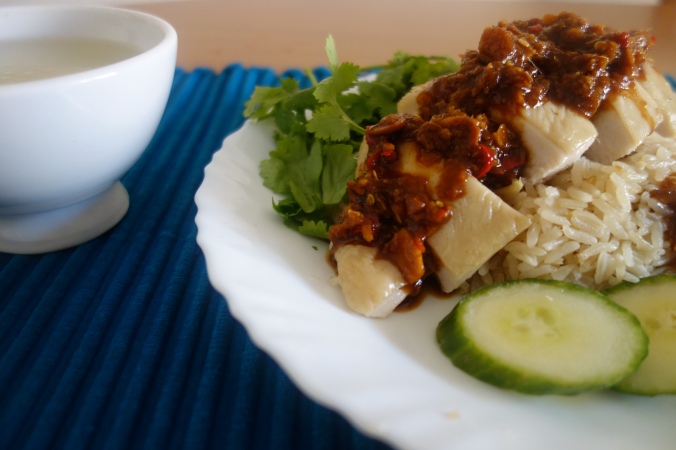What comes to mind when you think of Thai cuisine? I can imagine that for most people the usual suspects of Pad Thai and Green/Red/Yellow Curry spring to mind and then you are a bit lost. I admit it, I was one of those people. However, after having the pleasure of making Thai friends I have been introduced to more hardcore and less familiar dishes which you probably won’t find in your local Thai restaurant such as Nam Prik Pla Tu (Spicy Mackerel Paste) served with fried aubergine and cucumber, amazing homemade Sai Oua (Northern Thai Sausage) courtesy of Kwanta Kosayothin whose recipe I am dying to get my hands on, Nam Tok Moo (Spicy Pork Salad similar to the more well-known Laab) and to finish off on a sweet note, Khao Niew Mamuang (Mango & Sticky Rice). I love making friends with international people, mainly because of the food experiences that come with them. Thank you Nantisara Pipattanananti for coming into my life and opening my eyes (and belly) to this absolutely amazing cuisine!
Today’s recipe is one of those dishes that isn’t as well known to outside of Thailand: Khao Man Gai. It’s Thailand’s answer to Hainanese Chicken Rice and although the origin of the dish is from Hainan (Chinese Province), the major difference from the original is the dipping sauce that is served alongside the dish. Hainanese Chicken Rice is actually very popular across South East Asia and is even considered the National dish of Singapore.
Khao Man Gai literally means “oily rice chicken” as the rice is cooked in chicken fat. I must admit that the translation doesn’t sound all that appealing which is probably why in English it’s known as Hainanese Chicken Rice. Traditionally, the rice and chicken is served with a dipping sauce, cucumber, coriander, liver and congealed chicken blood. I’ve decided to skip the liver and blood though…
Traditionally the dipping sauce (and all curry pastes) is made in a large pestle and mortar but you can also use a food processor although the consistency will be affected. I actually used my grandmother’s old pestle and mortar which was solely used to make a traditional dish from La Mancha called Ajoarriero (Salt Cod and Potato “Paté”). Never had this mortar come into contact with such “exotic” ingredients in all its decades of existence before!
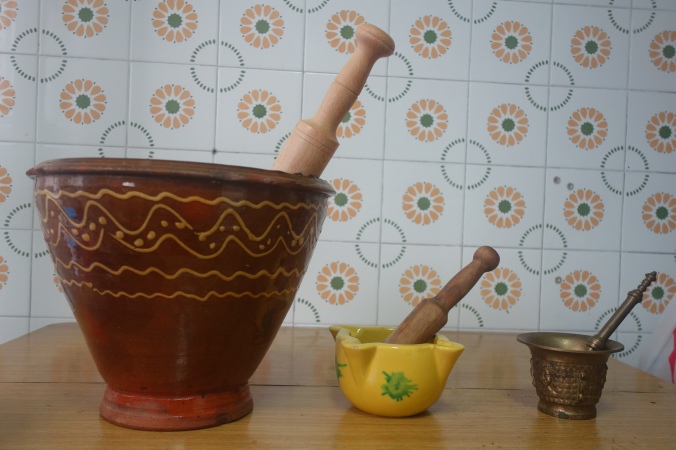
This recipe includes a few ingredients that you may be unfamiliar with if you are new to Thai cuisine (I had never heard of them before…).
1) Tao Jiew (เต้าเจี้ยว): Thai Fermented Soybean Paste. It is similar to Japanese miso or Korean doenjang and you if you have trouble finding the Thai stuff you could try substituting with one of these.
2) See Ew Dam (ซีอิ๊วดำ): known as Black Soy Sauce, it’s a thick type of soy sauce which has a sweet flavour. If you can’t find it you could try substituting with Indonesian Kecap Manis or Chinese Dark Soy Sauce but it is quite different.
3) Coriander roots: the roots of coriander (duh!). It is quite hard to find but sometimes you can find some roots still attached to coriander in Chinese supermarkets. You can try substituting with twice the amount of coriander stalks or omit entirely.
Ingredients
For the chicken:
1 whole chicken (mine was 2.2kg)
4 slices fresh ginger
4 whole garlic cloves, smashed
Coriander roots (if available)
1 spring onion
Salt, to taste
For the rice:
Chicken fats
5 cm fresh ginger, finely diced
5 cloves garlic, finely chopped
2 parts Thai Jasmine rice (no need to rinse in water)
4 parts chicken stock (from cooking the chicken)
For the dipping sauce:
5cm ginger, sliced
5cm ginger, finely diced
4 Thai Bird’s eye chillies, sliced
3 Tbsp. Tao Jiew
1 ½ Tbsp. brown sugar
2 Tbsp. See Ew Dam
1 ½ lemons, juiced
Garnishes:
Cucumber, sliced
Fresh coriander
Method
1 Remove excess chicken fat from the neck area and parson’s nose. If you don’t have much chicken fat you can use half fat and half vegetable oil. Reserve for later.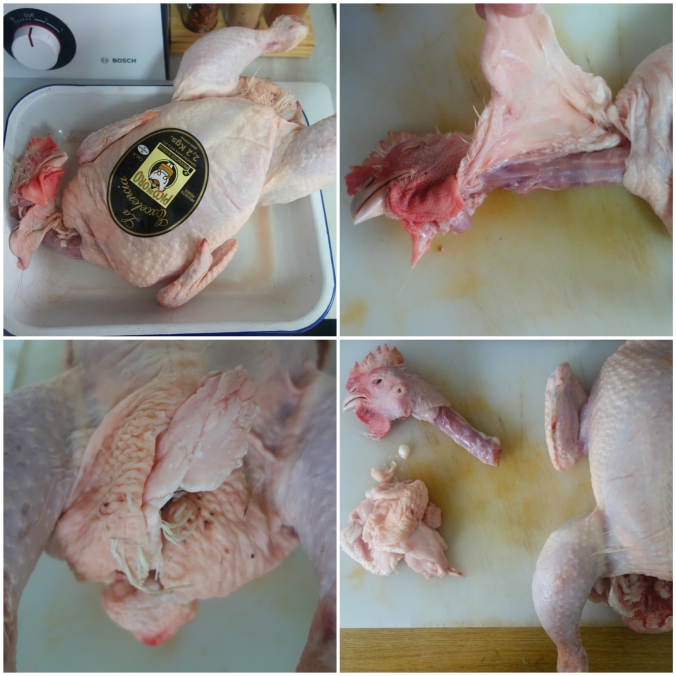 2 In a large stock pot add the ginger, spring onion, garlic cloves, coriander roots, salt and the whole chicken including its head and feet (if you have them). Cover the chicken completely with cold water. Bring to a slow boil and once you can see steam, turn the heat down to low; the water should not be a rolling boil. In Thailand they call this cooking the chicken in “still water”. Cook for a 40 minutes half covered (vary time according to your chicken; the meat should be cooked through but not falling off the bone), flipping the chicken halfway through cooking time. Remember to remove any of the scum that floats to the top once in a while. When the chicken is cooked, remove and leave to cool.
2 In a large stock pot add the ginger, spring onion, garlic cloves, coriander roots, salt and the whole chicken including its head and feet (if you have them). Cover the chicken completely with cold water. Bring to a slow boil and once you can see steam, turn the heat down to low; the water should not be a rolling boil. In Thailand they call this cooking the chicken in “still water”. Cook for a 40 minutes half covered (vary time according to your chicken; the meat should be cooked through but not falling off the bone), flipping the chicken halfway through cooking time. Remember to remove any of the scum that floats to the top once in a while. When the chicken is cooked, remove and leave to cool.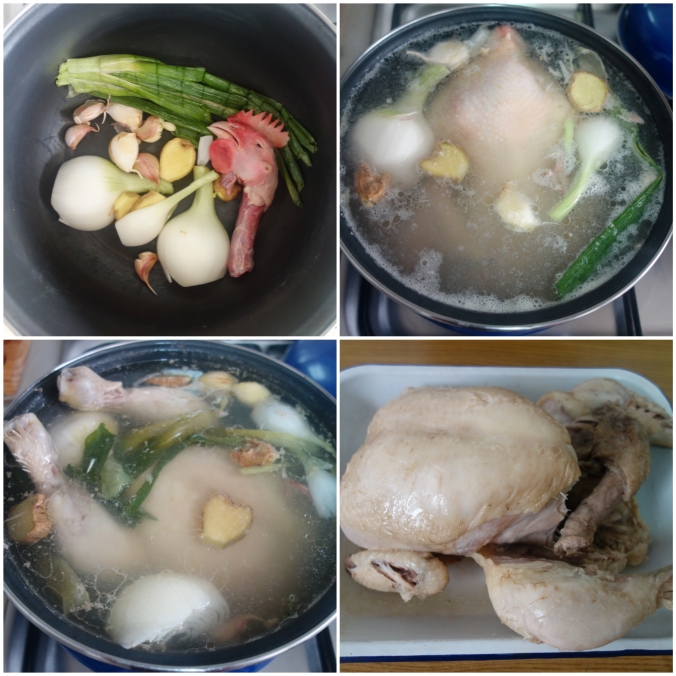 3 Render chicken fats in a saucepan until you get at least a few tablespoons of chicken oil. If you don’t get enough oil from the chicken fats you can also use some vegetable oil.
3 Render chicken fats in a saucepan until you get at least a few tablespoons of chicken oil. If you don’t get enough oil from the chicken fats you can also use some vegetable oil.
4 Fry garlic and ginger in this oil along with the chicken fats and then add the rice. Coat the rice well with all the chicken oil and then add the chicken stock. Bring to a boil, cover and simmer on a low flame for 10 -12 minutes (times may vary according to the rice you buy-check packaging).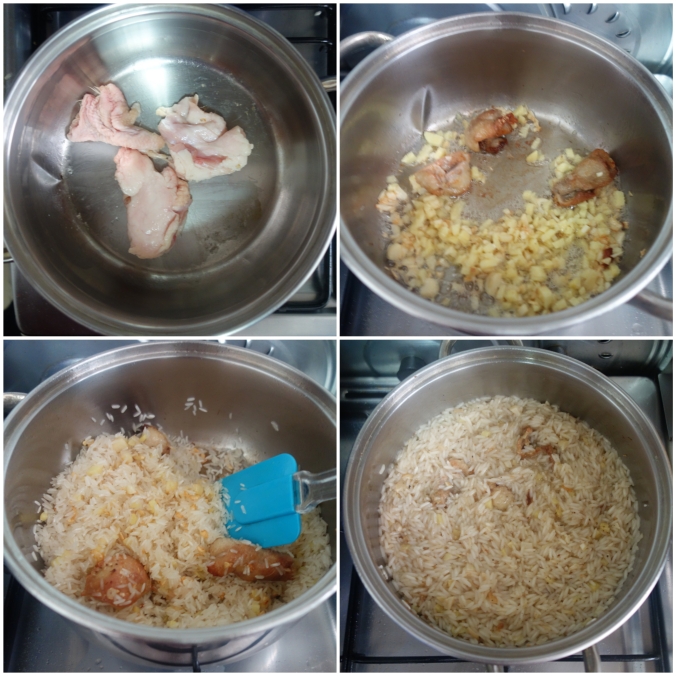 5 Make the dipping sauce by crushing ginger slices in large mortar until it becomes like a paste. Next add the finely diced ginger, chillies, Tao Jiew, sugar, See Ew Dam and lemon juice. Combine well. Adjust to your personal taste if needed.
5 Make the dipping sauce by crushing ginger slices in large mortar until it becomes like a paste. Next add the finely diced ginger, chillies, Tao Jiew, sugar, See Ew Dam and lemon juice. Combine well. Adjust to your personal taste if needed.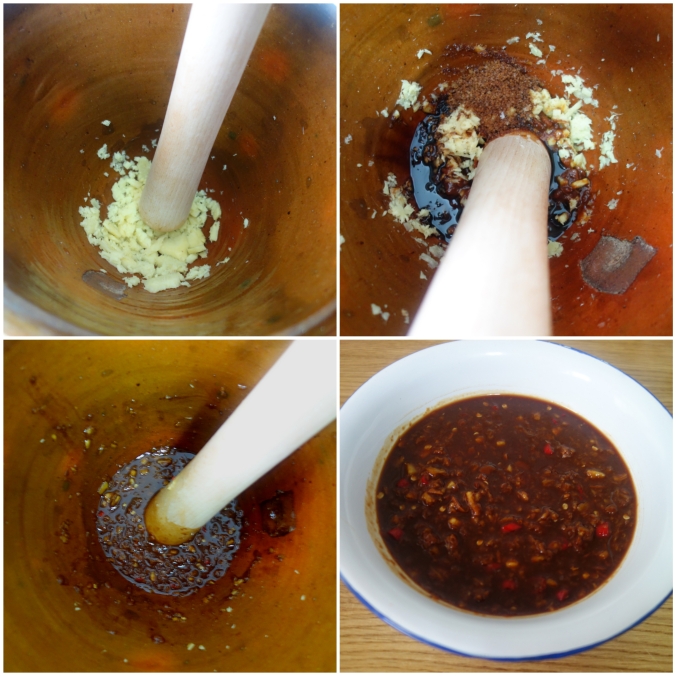 Assembly
Assembly
Carve the chicken by removing the drumsticks, thighs and both breasts. Remove the bones from the dark meat and slice all chicken into large pieces. The chicken is not served hot.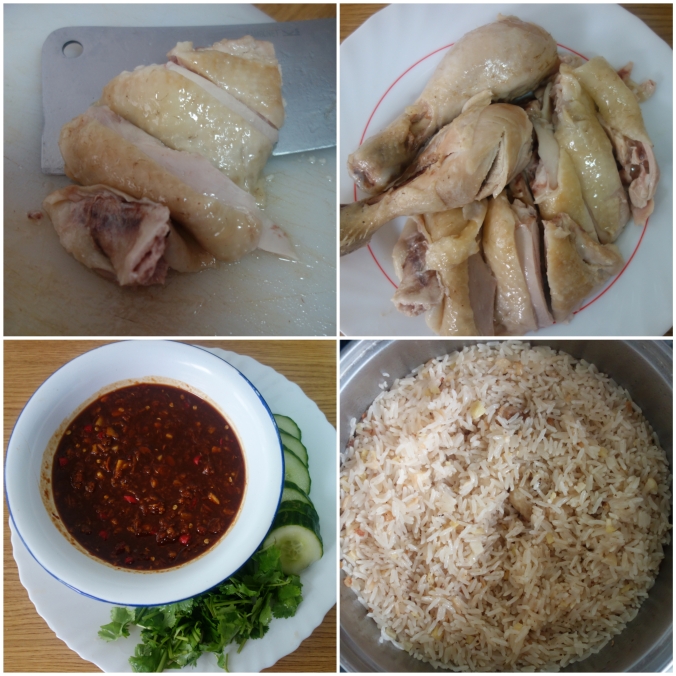 Lay whatever chicken you prefer (I always go for dark meat) on a bed of rice. Spoon over the sauce and garnish with cucumber and fresh coriander.
Lay whatever chicken you prefer (I always go for dark meat) on a bed of rice. Spoon over the sauce and garnish with cucumber and fresh coriander.
You can also eat it alongside a bowl of chicken broth especially in the winter when it’s colder. Some people also cook some winter melon in the stock but personally I prefer it plain.